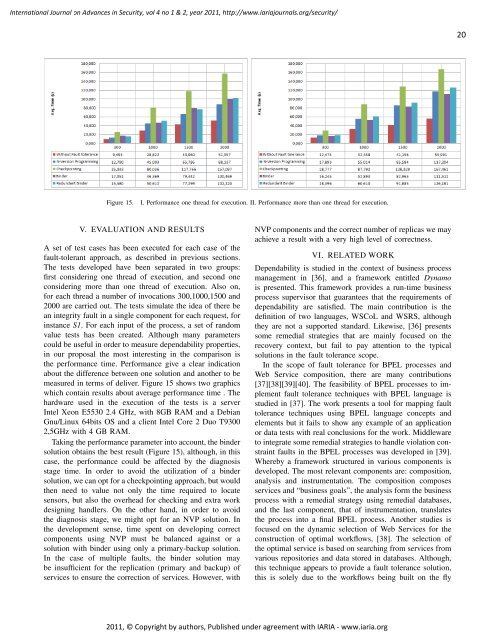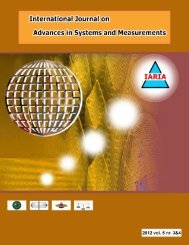Fault Tolerance Framework using Model-Based - IARIA Journals
Fault Tolerance Framework using Model-Based - IARIA Journals
Fault Tolerance Framework using Model-Based - IARIA Journals
Create successful ePaper yourself
Turn your PDF publications into a flip-book with our unique Google optimized e-Paper software.
International Journal on Advances in Security, vol 4 no 1 & 2, year 2011, http://www.iariajournals.org/security/<br />
Figure 15. I. Performance one thread for execution. II. Performance more than one thread for execution.<br />
V. EVALUATION AND RESULTS<br />
A set of test cases has been executed for each case of the<br />
fault-tolerant approach, as described in previous sections.<br />
The tests developed have been separated in two groups:<br />
first considering one thread of execution, and second one<br />
considering more than one thread of execution. Also on,<br />
for each thread a number of invocations 300,1000,1500 and<br />
2000 are carried out. The tests simulate the idea of there be<br />
an integrity fault in a single component for each request, for<br />
instance S1. For each input of the process, a set of random<br />
value tests has been created. Although many parameters<br />
could be useful in order to measure dependability properties,<br />
in our proposal the most interesting in the comparison is<br />
the performance time. Performance give a clear indication<br />
about the difference between one solution and another to be<br />
measured in terms of deliver. Figure 15 shows two graphics<br />
which contain results about average performance time . The<br />
hardware used in the execution of the tests is a server<br />
Intel Xeon E5530 2.4 GHz, with 8GB RAM and a Debian<br />
Gnu/Linux 64bits OS and a client Intel Core 2 Duo T9300<br />
2,5GHz with 4 GB RAM.<br />
Taking the performance parameter into account, the binder<br />
solution obtains the best result (Figure 15), although, in this<br />
case, the performance could be affected by the diagnosis<br />
stage time. In order to avoid the utilization of a binder<br />
solution, we can opt for a checkpointing approach, but would<br />
then need to value not only the time required to locate<br />
sensors, but also the overhead for checking and extra work<br />
designing handlers. On the other hand, in order to avoid<br />
the diagnosis stage, we might opt for an NVP solution. In<br />
the development sense, time spent on developing correct<br />
components <strong>using</strong> NVP must be balanced against or a<br />
solution with binder <strong>using</strong> only a primary-backup solution.<br />
In the case of multiple faults, the binder solution may<br />
be insufficient for the replication (primary and backup) of<br />
services to ensure the correction of services. However, with<br />
NVP components and the correct number of replicas we may<br />
achieve a result with a very high level of correctness.<br />
VI. RELATED WORK<br />
Dependability is studied in the context of business process<br />
management in [36], and a framework entitled Dynamo<br />
is presented. This framework provides a run-time business<br />
process supervisor that guarantees that the requirements of<br />
dependability are satisfied. The main contribution is the<br />
definition of two languages, WSCoL and WSRS, although<br />
they are not a supported standard. Likewise, [36] presents<br />
some remedial strategies that are mainly focused on the<br />
recovery context, but fail to pay attention to the typical<br />
solutions in the fault tolerance scope.<br />
In the scope of fault tolerance for BPEL processes and<br />
Web Service composition, there are many contributions<br />
[37][38][39][40]. The feasibility of BPEL processes to implement<br />
fault tolerance techniques with BPEL language is<br />
studied in [37]. The work presents a tool for mapping fault<br />
tolerance techniques <strong>using</strong> BPEL language concepts and<br />
elements but it fails to show any example of an application<br />
or data tests with real conclusions for the work. Middleware<br />
to integrate some remedial strategies to handle violation constraint<br />
faults in the BPEL processes was developed in [39].<br />
Whereby a framework structured in various components is<br />
developed. The most relevant components are: composition,<br />
analysis and instrumentation. The composition composes<br />
services and “business goals”, the analysis form the business<br />
process with a remedial strategy <strong>using</strong> remedial databases,<br />
and the last component, that of instrumentation, translates<br />
the process into a final BPEL process. Another studies is<br />
focused on the dynamic selection of Web Services for the<br />
construction of optimal workflows, [38]. The selection of<br />
the optimal service is based on searching from services from<br />
various repositories and data stored in databases. Although,<br />
this technique appears to provide a fault tolerance solution,<br />
this is solely due to the workflows being built on the fly<br />
2011, © Copyright by authors, Published under agreement with <strong>IARIA</strong> - www.iaria.org<br />
20







